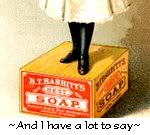Ugh. The Box is coming out early today.
I just read yet another article extolling the virtues of animal by-products and why these common pet food ingredients are (supposedly undeservingly) getting a bad rap. These articles are common in the pet food industry domain and typically include some form of the following argument:
“Humans have consumed by-products of the animals that we kill to eat for many generations. Depending on one’s culture, these take the form of a variety of foodstuffs, including items such as liver pate’, kidney soup, sausage and hotdogs, sweetbread, and haggis.
It follows [the argument goes] that to consider these same animal bits as unsavory, unsafe or lacking in nutritional value for our pets is unfounded. Clearly, since we eat or have eaten animal by-products, then these food items must also be safe and nutritious for our pets.
Hence, [these claims go], any resistance to the use of “by-products” in commercial pet foods is simply the result of pet owners falling for marketing campaigns aimed at maligning pet food companies that include ingredients carrying the “by-product” moniker in their foods.“
FULL STOP.
A Flawed Argument
It is time to call out these claims for the errors that they contain:
- First, the ingredients that are included in commercial pet foods and are labeled as animal by-product meals are NOT the same foods that humans use to produce dinner items such as liver and onions, sausage or even the infamous haggis. Today, the ingredients that we cook with are acquired via the human-grade (i.e. edible) food supply chain, not via the feed/pet grade ingredients supply chain. These two routes of food handling and processing differ in highly significant ways – most notably in their respective requirements for refrigeration and sanitary handling practices (or lack thereof). [See “Human-Grade Dog Food: Some Science” for details].
- Second, I am no chef, but as far as I know, there are no human food recipes that call for poultry by-product meal, chicken meal, or meat and bone meal. THESE are the by-product ingredients that are included in most (not all) commercial pet foods. (Note: If you are reading this and have a recipe that includes chicken by-product meal purchased from a renderer, please feel free to share it).
- Third. It is all about processing. When the phrase “meal” is added to a by-product label, this means that the organ meats, intestines, tripe (rumen) and other animal by-products (with poultry, this may include heads and feet), have been rendered into a dry protein meal. It is the handling and processing of these ingredients that makes them different nutritionally from human foods that may utilize similar by-products. Indeed, there is an increasing body of evidence that the protein quality of animal protein meals that are used in pet foods can vary from relatively high quality to very low quality (i.e. deficient in one or more essential amino acids; see “Tastes Like Chicken” and “Mind Your” for some of this evidence).
Therefore, it is both disingenuous and outright misleading to present the “by-product issue” as simply a brilliant marketing ploy rather than recognizing the clear differences between sausage that is produced for human consumption versus a pet food that uses a feed-grade, rendered animal protein meal.
One Valid Claim
There is one kernel of truth in the standard industry argument to promote by-products. This is the claim that the protein value of some (not all) of the animal parts labeled as by-products is of moderate to high nutritional value. Prior to rendering and extrusion (and the damage that excessive processing may cause), organ meats such as liver, heart, spleen, brains, and parts of offal (intestinal or rumen contents) can provide high quality protein and essential micronutrients to a food (see “What’s the Deal with Meals“).
However, once processed into a protein meal, all bets are off. At the point that a feed-grade, animal by-product meal has been produced and incorporated into a pet food, it must be assessed and evaluated as that ingredient because it is no longer the same thing as the liver that your mom used to make a holiday liver pate or that your relatives in Scotland enjoy as haggis.




You must have read the same thing I did, but I can’t remember where it was.
LikeLike